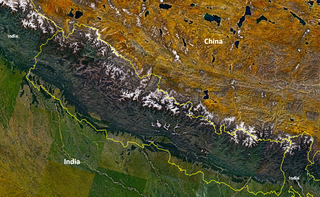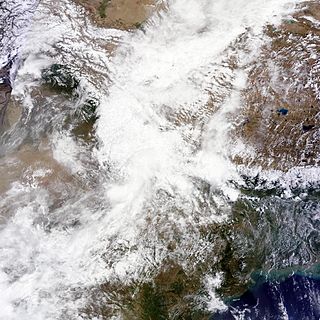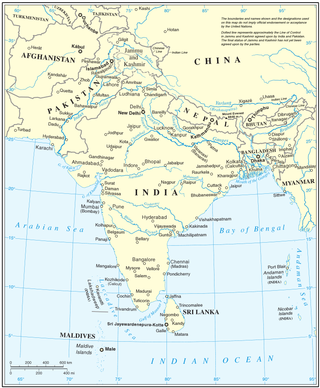Related Research Articles

Sindhupalchowk District is a part of Bagmati Province and one of the seventy-seven districts of Nepal, with an area of 2,542 km2 (981 sq mi). The district's headquarters is in Chautara. In 2006, 336,478 people resided in 79 village development committees, in 2011 there were 287,798.

Typhoon Chataan, known in the Philippines as Typhoon Gloria, was the deadliest natural disaster in the history of Chuuk, a state in the Federated States of Micronesia (FSM). The typhoon formed on June 28, 2002, near the FSM, and for several days it meandered while producing heavy rainfall across the region. On Chuuk, the highest 24-hour precipitation total was 506 mm (19.9 in), which was greater than the average monthly total. The rain produced floods up to 1.5 m (4.9 ft) deep, causing landslides across the island that killed 47 people. There was also one death on nearby Pohnpei, and damage in the FSM totaled over $100 million.
Melamchi is a municipality in Sindhupalchok District in the Bagmati Province of central Nepal. At the time of the 1991 Nepal census it had a population of 3936 and had 710 houses in the village.

The Sunkoshi, also spelt Sunkosi, is a river that is part of the Koshi or Saptkoshi River system in Nepal. Sunkoshi has two source streams, one that arises within Nepal in Choukati, and the other more significant stream that flows in from Nyalam County in the Tibet region of China. The latter is called Bhote Koshi in Nepal and Matsang Tsangpo in Tibet. Due to the significant flows from Bhote Koshi, the Sun Koshi river basin is often regarded as a trans-border river basin.

The 2010 Ladakh floods occurred on 6 August 2010 across a large part of Ladakh, then part of the state of Jammu and Kashmir. 71 towns and villages were damaged, including the main town in the area, Leh. At least 255 people are reported to have died, six of whom were foreign tourists, after a cloudburst and heavy overnight rains triggered flash floods, mudflows, and debris flows. 200 people were reported missing in the initial aftermath of the storm, and thousands more were rendered homeless after the flooding caused extensive damage to property and infrastructure. Overall, 9000 people were directly affected by the event.

Nepal was hit by serious flooding during May 2012.

2012 Himalayan flash floods are the floods that occurred on the midnight of 3 August 2012 in the Himalayan region of Northern Indian states. Many were dead and missing. Many places were affected. Landslides and flash floods were triggered by a sudden cloudburst which left 31 people dead while 40 are reported to be missing.

In June 2013, a mid-day cloudburst centered on the North Indian state of Uttarakhand caused devastating floods and landslides, becoming the country's worst natural disaster since the 2004 tsunami. The rainfall received that month was far greater than the rainfall the state usually received. Debris blocked the rivers, causing major overflow. The main day of the flood was 16 June 2013.
In mid-March 2019, monsoonal downpours caused widespread flooding and landslides across South Asia.

Melamchi Water Supply Project (MWSP) is a project to supply drinking water to Kathmandu Valley by diverting 170,000,000 litres of water per day. The project started in 1998 and completed in 2021. The intake of this project is located in Melamchi, Nepal. Ministry of Physical Infrastructure and Transport (Nepal) is the executing agency for the Project and Melamchi Water Supply Development Board is the implementing agency.
Landslides are triggered in Nepal due to a combination of steep mountains and unstable soils. The risk of the landslide is high in the monsoon season due to the lubrication of soil in the slope by moisture. Another important factor triggering the landslide is earthquakes. When landslide occurs near the river, it can block the river causing a damming effect. Damming could also occur due to rock-slides. Such dams are unstable and can cause flooding if not breached in controlled manner. Below is a list of dams formed due to landslides and their impacts in Nepal Annually, 593 natural disaster occurs in average and quite a few of them are related to the damming by landslides and about 13% of fatality is directly related to the landslide and Landslides Dammed Outburst Flood (LDOF).

The 2020 Nepal floods were induced by heavy rains causing landslides and flash floods in western Nepal, and in particular Myagdi District. As of 24 June, Nepal's Ministry of Home Affairs reported 132 dead, 53 missing, and 128 injured in 445 flooding and landslide incidents. Aon reported 401 fatalities from the floods.

The 2021 Uttarakhand flood, also known as the Chamoli disaster, began on 7 February 2021 in the environs of the Nanda Devi National Park, a UNESCO World Heritage Site in the outer Garhwal Himalayas in Uttarakhand state, India. It was caused by a large rock and ice avalanche consisting of material dislodged from Ronti peak. It caused flooding in the Chamoli district, most notably in the Rishiganga river, the Dhauliganga river, and in turn the Alaknanda—the major headstream of the Ganges. The disaster left over 200 killed or missing. Most were workers at the Tapovan dam site.
The 2021 floods and landslides in Sri Lanka are flash floods and mudslides which were caused from heavy torrential rainfalls during May and June 2021. As of 7 June 2021; the monsoon floods affected in about 10 districts, killing at least 17 persons including about 10 because of floods and 4 people because of mudslides. About 245,000 people were affected living in Colombo, Puttalam, Kandy, Kalutara, Kurunegala, Gampaha, Nuwara Eliya, Ratnapura and Galle. More than 800 houses were reported to have been damaged.

Melamchi River is a tributary of the Indrawati River. It originates from the Jugal Himal at an elevation of about 5,875 m (19,275 ft) above sea level. It joins the Indrawati River at Melamchi Bazaar.
2021 Nepal floods were a series of flash floods caused by heavy rains causing landslides and flash floods.

From January to October 2022, excessive rainfall and widespread monsoon flooding occurred in the South Asian countries of Afghanistan, Bangladesh, India, Nepal, Pakistan, and Sri Lanka. It has become the region's deadliest floods since 2020, with over 3,700 people dead.

After over 6,500 people died in flooding in 2020, monsoon floods hit South Asia again in 2021.
References
- ↑ "Destruction caused by floodwaters in Melamchi bazaar". Archived from the original on 2021-06-17. Retrieved 2021-06-19.
- ↑ Service, Himalayan News (2021-06-18). "At least 15 feared missing in Melamchi flood". The Himalayan Times. Archived from the original on 2021-06-19. Retrieved 2021-06-19.
- 1 2 "Drone Based Rapid Assessment of Melamchi Flood 2021". ArcGIS StoryMaps. 2021-07-05. Archived from the original on 2021-06-29. Retrieved 2021-07-06.
- ↑ "One dead, seven missing in Nepal monsoon flood". News24. Archived from the original on 2021-06-19. Retrieved 2021-07-06.
- ↑ "Flash floods kill 10 people in Bhutan, seven missing in Nepal". Reuters. 2021-06-16. Archived from the original on 2021-06-24. Retrieved 2021-07-06.
- ↑ "The cause of the Melamchi disaster in Nepal". The Landslide Blog. 2021-07-02. Archived from the original on 2021-07-02. Retrieved 2021-07-06.
- ↑ "Melamchi project headworks buried in mud, extent of damage unknown". Archived from the original on 2021-06-18. Retrieved 2021-07-06.
- ↑ "Landslides and floods kill 18 in Nepal". The Hindu. Kathmandu. 2021-06-20. ISSN 0971-751X. Archived from the original on 2021-07-06. Retrieved 2021-07-06.
- ↑ ANI (2021-06-17). "Glacial outburst suspected to be behind flash floods in Central Nepal". Business Standard India. Archived from the original on 2021-06-19. Retrieved 2021-07-06.
- ↑ "मेलम्ची बाढी अपडेट: ६० घर-टहरा बगायो, बाहुनेपाटी पुल जोखिममा". Setopati. Retrieved 2021-08-02.